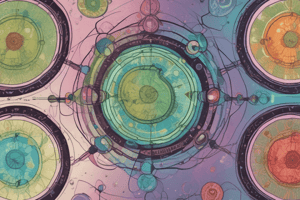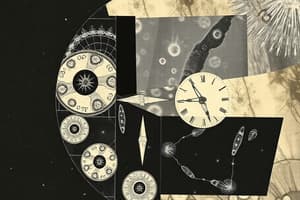Podcast
Questions and Answers
During which phase do the chromatids separate to form two sets of identical chromosomes?
During which phase do the chromatids separate to form two sets of identical chromosomes?
- Anaphase (correct)
- Prophase
- Metaphase
- Telophase
What process begins when the chromosomes move toward the centrioles at each end of the cell?
What process begins when the chromosomes move toward the centrioles at each end of the cell?
- Cytokinesis (correct)
- Cell plate formation
- Spindle fiber formation
- Nuclear division
Which phase is characterized by the alignment of chromosomes in the center of the cell?
Which phase is characterized by the alignment of chromosomes in the center of the cell?
- Anaphase
- Interphase
- Metaphase (correct)
- Telophase
What occurs during Telophase?
What occurs during Telophase?
What happens to the spindle fibers during Telophase?
What happens to the spindle fibers during Telophase?
What percentage of the total cell cycle is occupied by interphase?
What percentage of the total cell cycle is occupied by interphase?
Which phase of interphase is responsible for DNA replication?
Which phase of interphase is responsible for DNA replication?
During which phase of mitosis do the chromatin condense into chromosomes?
During which phase of mitosis do the chromatin condense into chromosomes?
Which process occurs quickly after karyokinesis in mitosis?
Which process occurs quickly after karyokinesis in mitosis?
What happens to the nuclear envelope and the nucleolus during prophase?
What happens to the nuclear envelope and the nucleolus during prophase?
Which of the following is NOT a part of the interphase?
Which of the following is NOT a part of the interphase?
What characterizes the G1 period of interphase?
What characterizes the G1 period of interphase?
Which of the following occurs at the end of the G2 period?
Which of the following occurs at the end of the G2 period?
What is the main outcome of meiosis?
What is the main outcome of meiosis?
Which stage of meiosis is characterized by the longest duration?
Which stage of meiosis is characterized by the longest duration?
During which phase do homologous chromosomes exchange segments?
During which phase do homologous chromosomes exchange segments?
What happens during Anaphase I?
What happens during Anaphase I?
Which process occurs simultaneously with Meiosis I?
Which process occurs simultaneously with Meiosis I?
In which meiotic phase are homologous pairs aligned at the center of the cell?
In which meiotic phase are homologous pairs aligned at the center of the cell?
What is a key feature of sister chromatids during Metaphase I?
What is a key feature of sister chromatids during Metaphase I?
How many divisions occur during meiosis?
How many divisions occur during meiosis?
What occurs during telophase I?
What occurs during telophase I?
Which statement is true about interkinesis?
Which statement is true about interkinesis?
During which phase of meiosis do sister chromatids separate?
During which phase of meiosis do sister chromatids separate?
What happens in metaphase II of meiosis?
What happens in metaphase II of meiosis?
Which of the following correctly describes telophase II?
Which of the following correctly describes telophase II?
What is the primary event of prophase II?
What is the primary event of prophase II?
How does meiosis differ from mitosis in terms of chromosome replication?
How does meiosis differ from mitosis in terms of chromosome replication?
What characterizes anaphase I in meiosis?
What characterizes anaphase I in meiosis?
Flashcards are hidden until you start studying
Study Notes
Cell Cycle Overview
- Comprises a cyclical process of growth and mitosis.
- Consists of two main stages: interphase and mitosis.
Interphase
- Represents about 90% of the total cell cycle.
- Is a period for normal cellular activities and functions.
- Nucleus is visible with distinct nucleoli; chromosomes appear as granular forms.
- Divided into three phases:
- G1 Phase: Early growth phase; cell increases in volume by producing tRNA, mRNA, ribosomes, and enzymes.
- S Phase: Continues growth; involves DNA replication.
- G2 Phase: Prepares for cell division; includes replication of mitochondria and organelles, synthesis of microtubules and proteins for spindle fibers, and chromosome condensation.
Mitosis
- Produces two daughter cells with identical chromosomes to the parent cell.
- Also known as duplication division; involves karyokinesis and cytokinesis.
- Consists of four phases:
- Prophase: Chromatin condenses into chromosomes; centrioles move apart; nucleolus and nuclear envelope disappear; mitotic apparatus starts forming.
- Metaphase: Fully formed mitotic spindle; chromosomes align in the cell center.
- Anaphase: Chromatids separate into two identical chromosome sets; chromosomes move to opposite cell ends; cytokinesis starts.
- Telophase: Chromosomes reach cell poles, uncoil, and nuclear membranes reform; cytokinesis completes, resulting in two daughter cells.
Cytokinesis
- Occurs after telophase, finalizing the cell division process.
Meiosis
- Produces four daughter cells with a haploid number of chromosomes.
- Known as reduction division; involves two divisions (meiosis I and meiosis II).
Meiosis I
- Reduces chromosome number; cytokinesis follows.
- Prophase I: Longest phase; homologous chromosomes pair and exchange segments (crossing over); spindle forms.
- Metaphase I: Homologous pairs align at the cell's center; sister chromatids remain attached.
- Anaphase I: Homologous chromosomes separate and migrate to cell poles; sister chromatids stay together.
- Telophase I: Chromosomes arrive at poles; each pole has a haploid set; cytokinesis forms two haploid daughter cells.
Meiosis II
- Similar to mitosis; occurs after interkinesis which is a resting phase without DNA replication.
- Prophase II: Spindle forms, chromosomes move to the cell's center.
- Metaphase II: Chromosomes align along the center.
- Anaphase II: Centromeres of sister chromatids separate and move to opposite poles.
- Telophase II: Nuclear membranes form around each haploid set of chromosomes, completing the division.
Studying That Suits You
Use AI to generate personalized quizzes and flashcards to suit your learning preferences.




